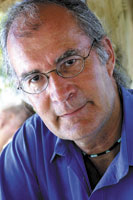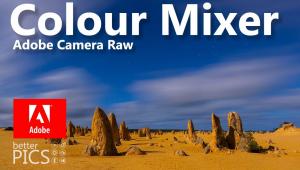When It Comes To Digital Imaging, It’s A Numbers Game
There are quite a few differences between film and digital imaging. One main
difference is that when it comes to film you are dealing with dye and density;
with digital it's all a numbers game. Once exposed and developed, film
has measurable and fairly fixed characteristics. With digital it's pretty
much up for grabs. That's because digital images are composed of codes,
either/or binary "addresses" that can be swapped for others without
much regard for the original codes set when the image is recorded and processed.
This becomes evident when you work in raw file format, where settings are malleable,
to say the least, and even more so when you put it in an image manipulation
Mixmaster like Photoshop, or any of the myriad programs and plug-ins available
today. Want to make that bunch of information emulate a continuous tone silver
print? No problem. Want it to look like a photocopy with red and green where
purple and orange once prevailed? Just put it into the mix.
 What makes much of digital work is the software that translates the codes to
a visual language that can be manipulated without resorting to actually digging
in and working with the codes themselves. We are presented with sliders, curves,
and previews that change the image in subtle or profound ways with the click
of a mouse. We can play all sorts of "what if" games with layers
and plug-in special effects. We can shift contrast by tweaking a curve, and
emulate any photomechanical medium, printed on virtually any surface, with a
few keystrokes and twists of the wrist. And we see it all happen right in front
of us, in pretty much "real time" on the screen as we work. It's
rather amazing when you consider the computation power that those changes require,
and the speed at which it all takes place.
What makes much of digital work is the software that translates the codes to
a visual language that can be manipulated without resorting to actually digging
in and working with the codes themselves. We are presented with sliders, curves,
and previews that change the image in subtle or profound ways with the click
of a mouse. We can play all sorts of "what if" games with layers
and plug-in special effects. We can shift contrast by tweaking a curve, and
emulate any photomechanical medium, printed on virtually any surface, with a
few keystrokes and twists of the wrist. And we see it all happen right in front
of us, in pretty much "real time" on the screen as we work. It's
rather amazing when you consider the computation power that those changes require,
and the speed at which it all takes place.
Does working with codes rather than dye and density denigrate the work or make it "non-photographic"? The thing about digital is that it is the ultimate emulator, a copier par excellence. As software becomes more sophisticated, and the folks who work in the medium become more adept, it becomes less a question of it being truly photographic and more a matter of it being a new medium that occasionally uses photographic images as the message. It does not rival photography--it envelops it.
With all this in mind our focus for this issue is on software, the translator and transformer of our images. One of our main features, offered up by Joe Farace, is on the highlights of new software premiered in the last few months and spotlighted at the recent Photo Marketing Association Show. Aside from a host of upgrades, there is new software for every conceivable task, from making scrapbooks from the old family album to organizing vast collections to making expressive images that might just change the way we think about what a picture means.
After you peruse that and other software related articles in this issue you might wonder if there's anything software can't do for your images these days. Yes, it can stir your imagination and yes, it can offer up new ways of making different and in many cases better quality digital images. But there is one thing it can't do--it can't look through your viewfinder and compose a picture, or find meaning in images that only you and your individual point of view bring to the equation. And it sure can't tell you what to do with your image once you've got it sitting on the screen in front of you. That's where your photographic skills come to the fore, and where your eye, heart, and sometimes guts come into play. It's a good tool for whatever you might have in mind, but it can never replace the heart and soul of a photographer's creativity and vision.

 What makes much of digital work is the software that translates the codes to
a visual language that can be manipulated without resorting to actually digging
in and working with the codes themselves. We are presented with sliders, curves,
and previews that change the image in subtle or profound ways with the click
of a mouse. We can play all sorts of "what if" games with layers
and plug-in special effects. We can shift contrast by tweaking a curve, and
emulate any photomechanical medium, printed on virtually any surface, with a
few keystrokes and twists of the wrist. And we see it all happen right in front
of us, in pretty much "real time" on the screen as we work. It's
rather amazing when you consider the computation power that those changes require,
and the speed at which it all takes place.
What makes much of digital work is the software that translates the codes to
a visual language that can be manipulated without resorting to actually digging
in and working with the codes themselves. We are presented with sliders, curves,
and previews that change the image in subtle or profound ways with the click
of a mouse. We can play all sorts of "what if" games with layers
and plug-in special effects. We can shift contrast by tweaking a curve, and
emulate any photomechanical medium, printed on virtually any surface, with a
few keystrokes and twists of the wrist. And we see it all happen right in front
of us, in pretty much "real time" on the screen as we work. It's
rather amazing when you consider the computation power that those changes require,
and the speed at which it all takes place. Does working with codes rather than dye and density denigrate the work or make it "non-photographic"? The thing about digital is that it is the ultimate emulator, a copier par excellence. As software becomes more sophisticated, and the folks who work in the medium become more adept, it becomes less a question of it being truly photographic and more a matter of it being a new medium that occasionally uses photographic images as the message. It does not rival photography--it envelops it.
With all this in mind our focus for this issue is on software, the translator and transformer of our images. One of our main features, offered up by Joe Farace, is on the highlights of new software premiered in the last few months and spotlighted at the recent Photo Marketing Association Show. Aside from a host of upgrades, there is new software for every conceivable task, from making scrapbooks from the old family album to organizing vast collections to making expressive images that might just change the way we think about what a picture means.
After you peruse that and other software related articles in this issue you might wonder if there's anything software can't do for your images these days. Yes, it can stir your imagination and yes, it can offer up new ways of making different and in many cases better quality digital images. But there is one thing it can't do--it can't look through your viewfinder and compose a picture, or find meaning in images that only you and your individual point of view bring to the equation. And it sure can't tell you what to do with your image once you've got it sitting on the screen in front of you. That's where your photographic skills come to the fore, and where your eye, heart, and sometimes guts come into play. It's a good tool for whatever you might have in mind, but it can never replace the heart and soul of a photographer's creativity and vision.


































